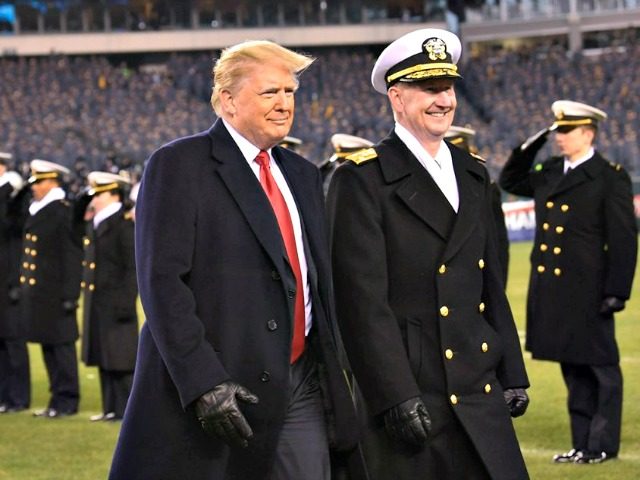The Pentagon this week unveiled a $750 billion budget request for 2020 — the Trump administration’s first budget request since the release of its National Defense Strategy that prioritizes great power competition with China and Russia.
“The budget requests $750 billion for our national defense. And to be clear, this is not funding for endless wars, this is for research and development and procurement to fund the most awe-inspiring military the world has ever known,” White House Press Secretary Sarah Sanders said Monday.
The $750 billion request includes emergency funding that would go towards rebuilding military facilities hit by hurricanes, as well as $3.6 billion in military construction funds for the border wall, and another $3.6 billion to backfill the money for military construction President Trump intends to use as part of the national emergency declaration for the wall.
The budget would also support a 3.1 percent military pay raise.
The $750 billion request marks a $34 billion increase from 2019’s enacted defense budget, or about a three percent real growth increase. Of the $750 billion, $718 billion would go to the Pentagon, and $32 billion would go towards non-Pentagon defense spending, such as in the Department of Energy.
The $718 billion roughly breaks down into the following accounts: $156 billion for military personnel; $293 billion for operations and maintenance; $143 billion for procurement of weapons; $104 billion for research, development, test, and engineering; $1 billion for revolving and management funds; and $21 billion for military construction.
The budget will buy five more Navy ships, 82 more aircraft, one more Air National Guard Combat Coded Squadron and six more aircraft, and pay for 7,700 more active and reserve forces.
The budget request identifies four priority areas aligned with its focus on China and Russia: investing in space and cyber; modernizing capabilities in the air, sea, and land domains; rapid innovation; and improving military readiness.
For space and cyber, the budget request would allocate $23.7 billion, including $14.1 billion for standing up the new U.S. Space Force headquarters.
To modernize capabilities in the air, sea, and land domains, the budget request would allocate $57.7 billion for more aircraft, refueling aircraft, and missiles; $34.7 billion for unmanned surface and underwater vehicles and long-range missiles; and $14.6 billion for 6,402 combat and tactical motorized vehicles and close combat systems.
It would also allocate $13.6 billion for improving missile defense, $14 billion for recapitalizing and enhancing the nuclear enterprise; and $3.4 billion for special operations forces.
In rapid innovations, $3.7 million will go towards the development of an offensive-armed unmanned surface vessel, an unmanned undersea vehicle, and autonomous logistics platforms; $927 million towards artificial intelligence projects; $2.6 billion towards hypersonics; and $235 million towards directed energy, or laser.
For readiness, $124.8 billion would fund depot maintenance across the services; $41.2 billion would go towards getting tactical aviation to 80 percent readiness levels as first mandated by former Defense Secretary Jim Mattis; $2.6 billion would towards more training for cyber operations, $1.5 billion for training facilities and rangers.
The Pentagon’s budget request overview concluded that the budget “marks a key shift in preparing to deter or defeat great power adversaries well into the future.”
“Congressional approval of the FY 2020 budget will help us outpace the threats posed by China and Russia and maintain our competitive advantage, while holding DOD spending near historical lows as a share of the U.S. economy,” it said.
Of the $718 billion request, $545 billion would fall into the Pentagon’s base budget, and abide by budget caps put into place in 2011 by Congress, known as sequestration, meant to shrink government spending. That would mean Congress would not to separately approve going beyond those caps, as in previous years since 2013.
The rest, $173 billion, would fall into the Pentagon’s Overseas Contingency Operations (OCO) – essentially a war fund account that does not have to abide by the budget caps, but would still need congressional approval.
Although OCO was created in 2001 to pay for short-term war-related costs, it has increasingly been used to pay for things in the base budget — to the ire of lawmakers who criticize its use as a “slush fund.”
The Trump administration’s 2020 budget request openly acknowledges that not all of the $164 billion requested in OCO would be for war funding. It says $66 billion would be for actual war funding, and $98 billion of that would be for the base budget. And $9 billion would be for emergency funding for the wall, and to backfill any military construction funding used.
With Democrats in control of the House, it is unlikely they approve all of the $750 billion for defense.
A Politico story in December reported that the $750 billion figure was just a negotiating tactic to get Congress to bring the final number higher. Previously, the Pentagon had said it wanted $733 billion.
Acting Defense Secretary Patrick Shanahan and Chairman of the Joint Chiefs of Staff Marine Gen. Joseph Dunford are set to testify before the Senate Armed Services Committee on Thursday on budget request.
It will be Shanahan’s first testimony before Congress as acting defense secretary, and Dunford’s last budget hearing before the committee, as he is slated to retire this year.

COMMENTS
Please let us know if you're having issues with commenting.